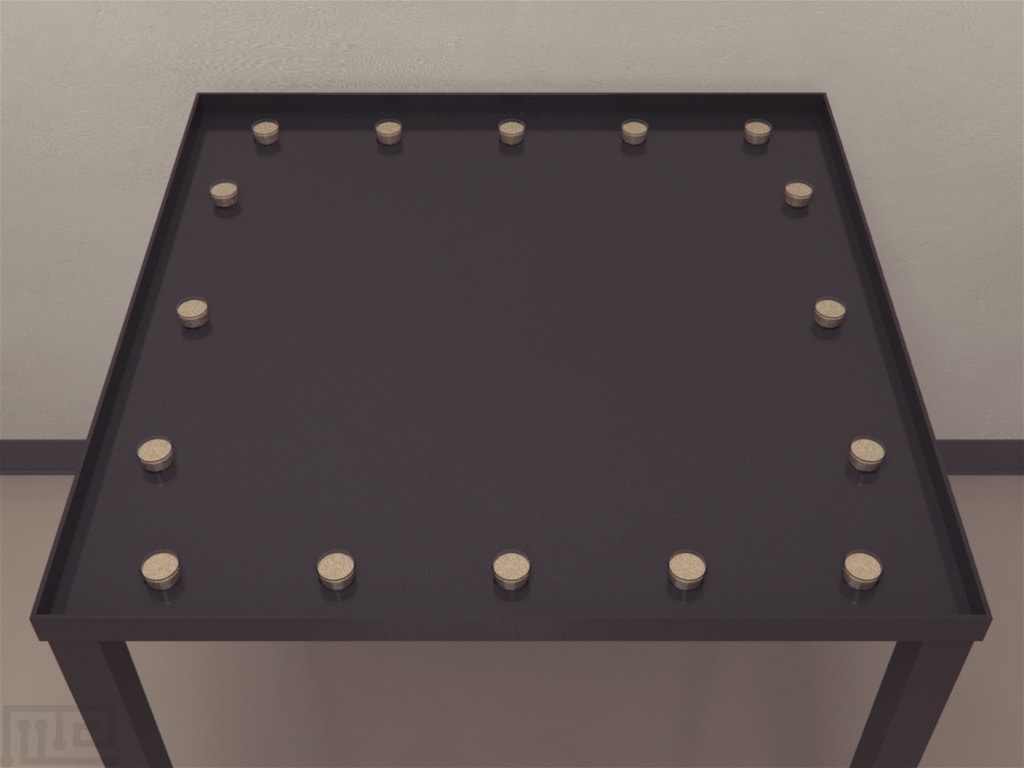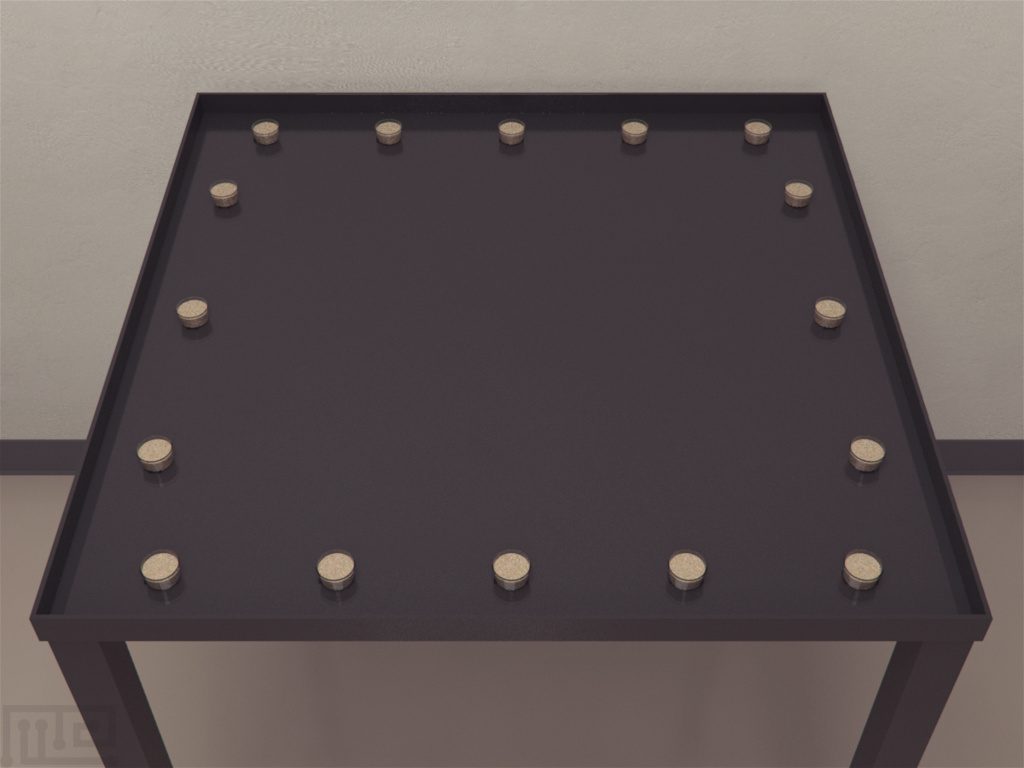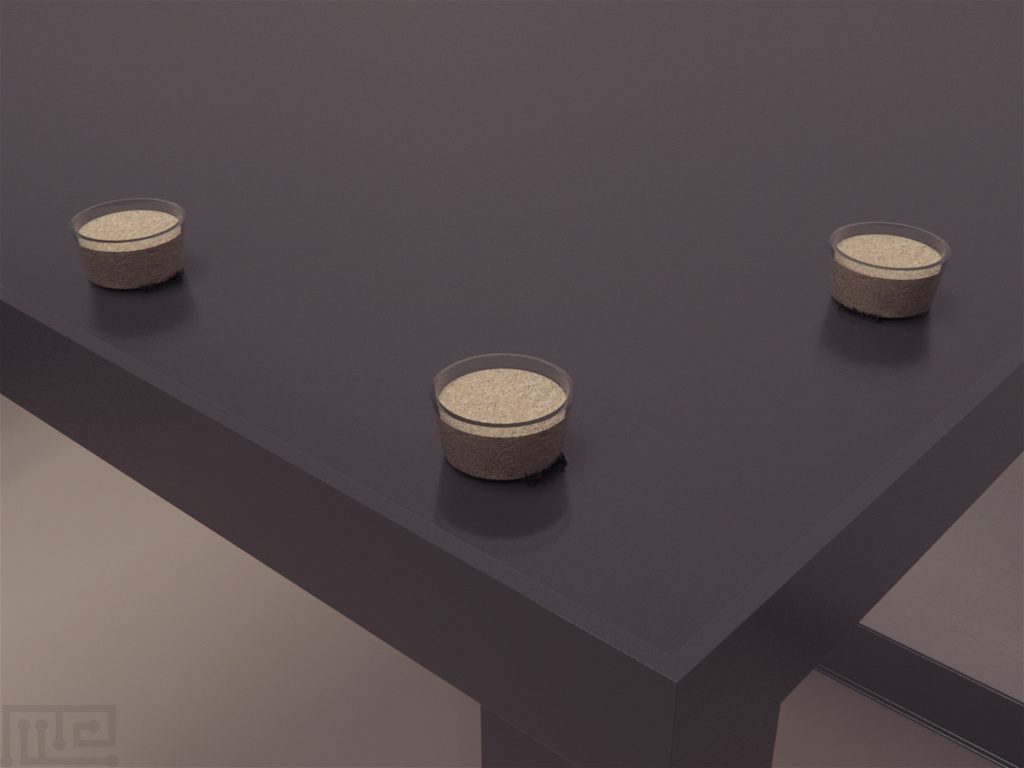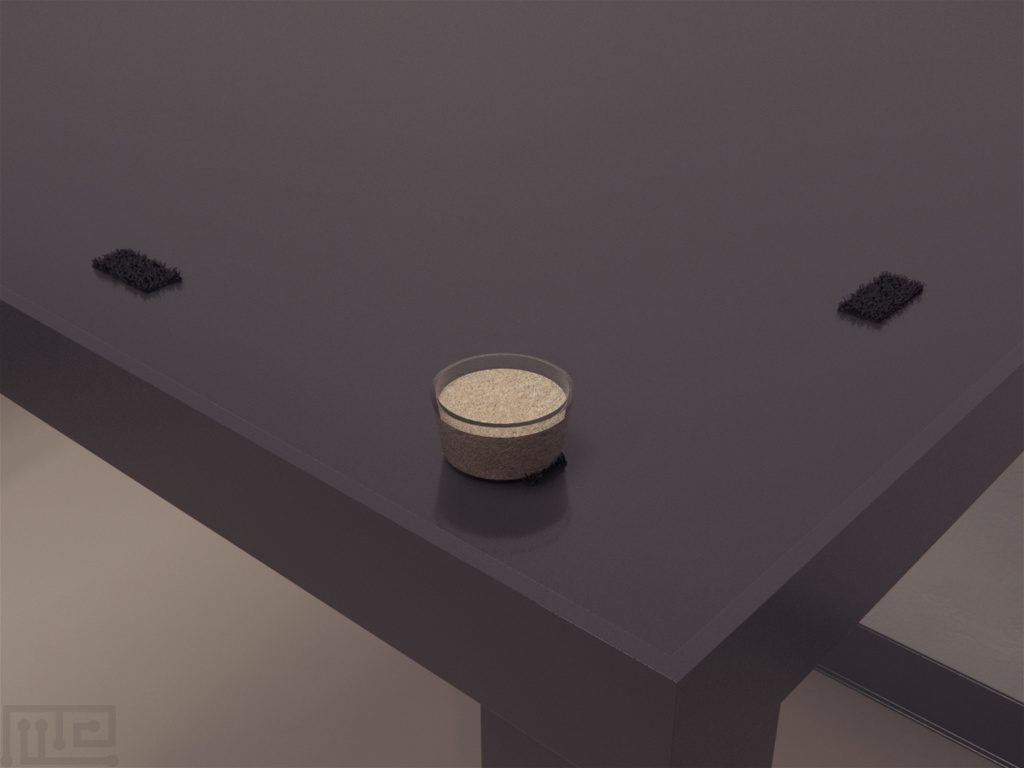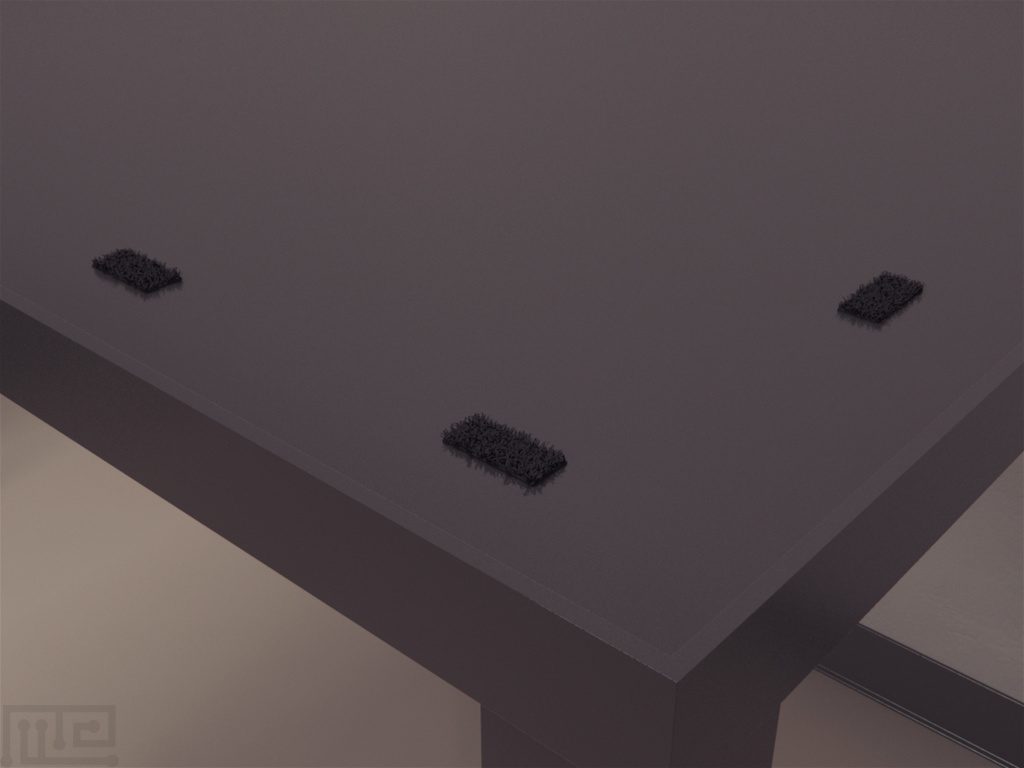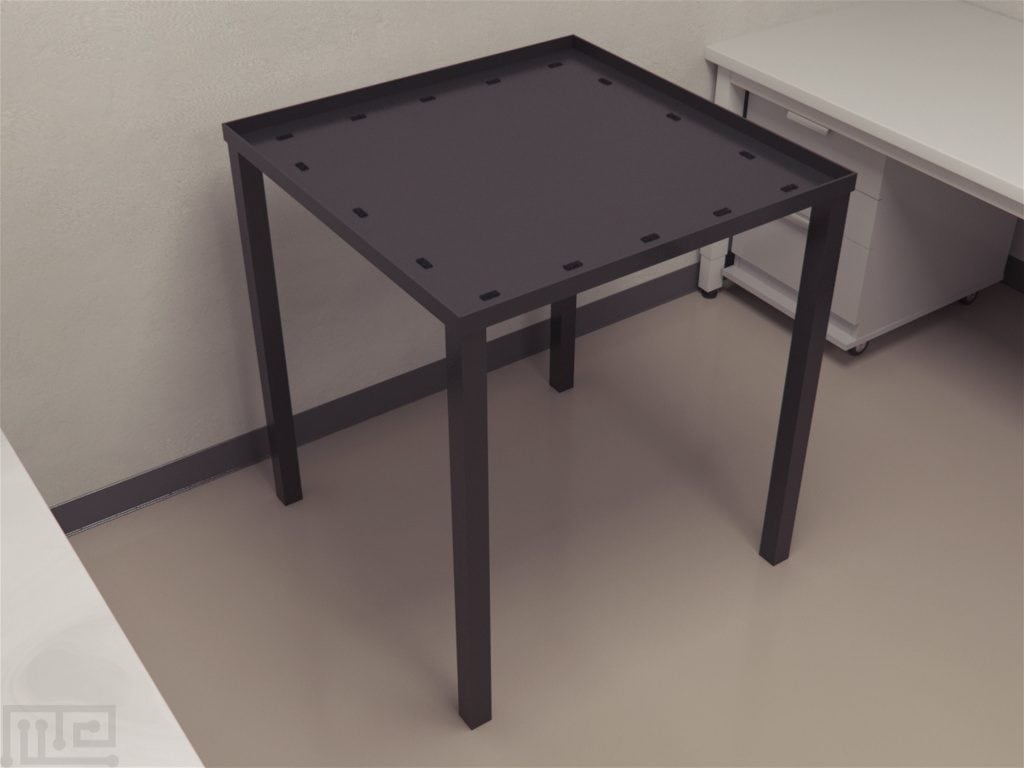The odor span apparatus tests the contribution of the hippocampus to normal memory capacity in rodents using location span tasks. In the odor span task, rodents are assessed in their ability to remember increasing numbers of odors. It is a widely used test to detect subtle changes in olfactory working memory can study subtle effects of genetic induction or drug effects in rodents.
Price & Dimensions
Mouse
$ 1790
Per Month- Platform: 2.5 ft x 2.5 ft x 2.5 ft
- Border: 1 in high
- Height: 39 in above floor
- Twenty-five scent cups
- cocoa, cumin, orange, lemon, celery, thyme, basil, fennel, paprika,
parsley, allspice, coffee, dill, cloves, marjoram, mint,
cinnamon, oregano, tea, ginger, garlic, caraway, anise, sage, and
nutmeg.
Rat
$ 1890
Per Month- Platform: 3 ft x 3 ft x 3 ft
- Border: 1.25 in high
- Height: 39 in above floor
- Twenty-five scent cups
- cocoa, cumin, orange, lemon, celery, thyme, basil, fennel, paprika,
parsley, allspice, coffee, dill, cloves, marjoram, mint,
cinnamon, oregano, tea, ginger, garlic, caraway, anise, sage, and
nutmeg.
Documentation
Introduction
The Odor Span Task (OST) is used to study olfactory working memory capacity in rodents. First developed by Dudchenko et al., to study nonspatial working memory using different odors and effects of hippocampal lesions on the performance of rats in the task. The apparatus was then slightly modified by Young et al., a few years later to study olfaction working memory in transgenic mice for the first time. Different variations of OST have been used since its development to study behavioral pharmacology in animal models of amnestic drugs, stimulant drugs, and other drugs that affect memory and learning. The OST has shown potential for use as a biomarker for diseases like Alzheimer’s disease and Schizophrenia as the reduction in odor recognition capability and memory is one of the earliest signs. The OST can also be used to test novel compounds for treatments of neurological diseases.
The OST is an incrementing non-matching-to-sample task in which the number of stimuli to-be remembered (the span) was increased after every correct response. The subjects are exposed to a series of odor stimuli and selection of new stimuli is reinforced. The task is conducted on a square platform with 24 positions marked around the perimeter of the platform for placement of odor stimulus in the form of scented sand in a cup. Span length and errors made during the task are recorded for analysis.
Apparatus & Equipment
The OST is conducted on a black plexiform square platform supported by four legs rested 39 inches above the floor. The platform is 2.5 ft x 2.5 ft x 2.5 ft with a 1-inch high border around the platform’s perimeter when testing mice and 3 ft x 3 ft x 3 ft with a 1.25 inches high border when testing rats. 24 positions are marked along the platform’s perimeter, with 4 positions at each corner of the platform and 5 positions equally spaced along each border with strips of Velcro. Cups made up of clear acrylic with a diameter of 6.5 cm, and a height of 3.5 cm is used for the scented sand mixture. The bottom of the cups also has a piece of Velcro attached making it easier to place the cups on the platform, which also prevents the cups from tipping over during the trials. The scented sand is made by mixing 0.5 grams of odor with 100 grams of unscented playground sand. Woodchip can also be used instead of unscented playground sand. There are 25 different odors used to make up the scented mixtures in the task such as cocoa, cumin, orange, lemon, celery, thyme, basil, fennel, paprika, parsley, allspice, coffee, dill, cloves, marjoram, mint, cinnamon, oregano, tea, ginger, garlic, caraway, anise, sage, and nutmeg.
Training Protocol
The subjects are housed in groups with the room temperature maintained at 21±10C and a 12 hour light/dark cycle. The subjects are moderately food-deprived and maintained at 85% of their free-feeding weight with free access to water throughout training and testing. The training and testing of subjects take place during the light phase of the cycle. The platform is cleaned with 100% ethanol at the start and end of each trial to remove any unwanted stimuli that can affect the performance of the subjects in the task.
Shaping Protocol
The subjects are habituated to handling before training for 10 minutes every day for 3 consecutive days. Put unscented playground sand in a cup and bury 10 reward pellets in it. Place the cup on the platform at a random location. Remove a subject from its home cage and place it on the platform. Allow the subject to dig, retrieve and consume all the reward pellets. Place the subject back into its home cage.
The following day, take 100 grams of unscented playground sand and mix it with 18 crushed reward pellets. Take 5 grams of this mixture in two cups each and bury 5 reward pellets in only one of the cup. Place the cups on the platform at random locations. Remove the subject from its home cage and place it on the platform. Allow the subject to dig, retrieve and consume all 5 reward pellets. Place the subject back into the home cage. Repeat this process immediately with the same cup baited with reward pellets.
Odor nonmatching to sample
The trial consists of a sample and choice phase.
Sample Phase
For the sample phase, place a cup containing randomly selected scented sand with one reward pellet buried in it at a random location on the platform. Place the subject on the platform and allow it to dig, retrieve and consume the reward pellet. Remove the subject once it consumes the reward pellet and place it in an opaque bucket. Move the cup to a new location on the opposite side of the platform. Place the second cup with another randomly selected scented sand with one reward pellet buried in it at a random location on the platform.
Choice Phase
For the choice phase of the trial, place the subject on the platform and allow it to dig, retrieve and consume the reward pellet from the second cup. Remove the subject and place it in an opaque bucket. Also, remove the first scented cup and move the second scented cup to a random location on the platform.
Place a third cup containing randomly selected scented sand with one reward pellet buried in it on the platform at a random location. Place the subject on the platform and allow it to dig, retrieve and consume the reward pellet from the third cup. Remove the subject and place it in an opaque bucket. Also, remove the second scented cup and move the third scented cup to a random location on the platform. Place a fourth cup containing randomly selected scented sand with one reward pellet buried in it on the platform at a random location.
Place the subject on the platform and allow it to dig, retrieve and consume the reward pellet from the fourth cup. Repeat this process using sample and choice phase, each time introducing a novel scented sand. A total of 10-12 nonmatching to sample (NMS) trials are given per day for 3 days or until the subject reliably selects the new odor each time. The odors used are selected randomly, and at the end of 3 days, the subject should have been exposed to all 25 odors.
Odor Span Task
Each span trial consists of a sample and choice phase. For the sample phase, place a cup containing randomly selected scented sand with one reward pellet buried in it at a random location on the platform. Place the subject on the platform and allow it to dig, retrieve and consume the reward pellet. Remove the subject and place it in an opaque bucket after it consumes the reward pellet. Move the first cup to a random location on the platform. Place a second cup containing randomly selected scented sand with one reward pellet buried in it at a random location on the platform. For the choice phase, place the subject on the platform and allow it to dig, retrieve and consume the reward pellet before placing it back into the opaque bucket. If the subject starts digging in the first cup, remove it immediately and place it in the opaque bucket. The trial is then restarted.
Next, introduce a third cup containing randomly selected scented sand with one reward pellet buried in it at a random location on the platform. Move the first and second cup to different locations on the platform. Place the subject on the platform and allow it to dig, retrieve and consume the reward pellet then return it back into the opaque bucket. Continue with the process by adding a new randomly selected scented sand baited with one reward pellet at a random location on the platform and moving the previously sampled scented sand cups to new locations every time the subject makes a correct decision by choosing the baited sand. The trial is terminated if the subject chooses previously sampled cup and a new span trial is started from the beginning with one scented sand cup on the platform. The subjects are given as many span trials as possible for 15-20 minutes (2-5 trials) of the testing period for 4 consecutive days.
Twelve-odor span task
After completion of the OST when the subject has a mean span of 5 over 2 consecutive days or has gone through at least 20 trial sessions, it is put through the final stage of testing. In this task, the subjects are given one span trial per day for 7 days, with sample and choice phase as described above for OST until twelve odors have been presented. If the subject makes an incorrect choice, it is allowed to explore other scented cups on the platform until it selects the correct scented cup (baited). The trial continues by adding newly scented sands until all 12 odors have been sampled.
Probe sessions
Two probe sessions can be used for verification.
Probe one – Reward
It is used to verify if the subjects were using odor of the scented sand rather than the odor of the reward pellet to solve the task. For this session, the trial is conducted in the same manner as described in the OST but without any reward pellet buried in the cups. The reward is only given when the subject chooses the correct cup by starting to dig in it.
Probe two – Cup change
It is used to verify if the subjects were marking either the cups or the sand to complete the task. For this session, the trial is conducted in the same manner as the OST. At two points during the trial, with 5 cups (Span 4) and 9 cups (Span 8) on the platform, all the sand and cups are replaced with new sand and cups containing same odors.
The role of Odor Span Task in Spatial Span, Recognition, and Alternation
Dudchenko et al., developed novel span tasks to study effects of hippocampal damage on memory capacity in rats. One of the tasks was Odor Span Task (OST) which required the subjects to remember a variable number of odors to get a reward. The subjects were also tested using Spatial Span Task (SST) which required the subjects to remember a variable number of locations on the platform. The results of the trials showed that the subjects with hippocampal lesions were able to remember up to 24 different odors similar to control subjects. The lesioned rats, when tested using delayed NMS task, showed impairment at a long delay. This shows that the hippocampus may be important for odor recognition memory at more prolonged delays.
Assessing working memory through Odor Span Task
Young et al., modified OST previously used for rats to study working memory in transgenic mice. They used mice that were over-expressing human caspase-3, an apoptogenic protein which is found in large numbers throughout the olfactory system. The study showed that the transgenic mice have significant olfactory working memory deficits with decreased span length, lower percentage accuracy and higher error rate as compared to wild-type mice. They also showed that nicotine which is used to enhance attention in mice could reverse olfactory working memory deficit. The task can be used in animal models of neurological diseases and test different treatments, as it can detect subtle changes in olfactory working memory of genetically modified animals. The Mouse OST can be the basis for developing tests of working memory in humans and can be used for early-disease bio-markers for diseases like Alzheimer’s disease and schizophrenia, as deficits in odor recognition and memory are one of the earliest signs observed.
Evaluation of the effect of stimulant drugs on Odor Span Task performance
Galizio et al., used a modified version of OST to test effects of stimulant drugs like flunitrazepam, ketamine, methamphetamine, and methylphenidate on the performance of rats. All of the four drugs produced dose-dependent impairment of performance shown by a decrease in span length, longest run, and overall accuracy. Methamphetamine and methylphenidate decreased span length and longest run at moderate to high doses which do not support the fact that such drugs are used for the treatment of Attention-Deficit-Hyperactivity-Disorder (ADHD) to enhance working memory and attention. Ketamine study results showed selective effect only in two rats as compared to flunitrazepam which produced selective impairment in several rats. Overall, the findings of the study suggest that the OST can be used for behavioral, pharmacological analysis of remembering.
Strengths & Limitations
Strengths
The OST is easy to set up and requires very little equipment to run. The apparatus used can be easily cleaned and maintained. The testing protocol can be modified and used in various areas of research from behavioral pharmacology to studying working memory in genetically modified animals.
Limitations
The OST is time-consuming as it requires multiple training and testing protocols.
Summary & Key Points
- The Odor Span Task (OST) is used to study olfactory working memory capacity in rodents.
- The OST is an incrementing non-matching-to-sample task in which the number of stimuli to-be remembered was increased after every correct response.
- The task is conducted on a square platform with 24 positions marked around the perimeter of the platform for placement of odor stimulus in the form of scented sand in a cup.
- The testing protocol can be modified and used in various areas of research from behavioral pharmacology to studying working memory genetically modified animals.
References
Dudchenko PA, Wood ER, Eichenbaum H (2000). Neurotoxic hippocampal lesions have no effect on odor span and little effect on odor recognition memory but produce significant impairments on spatial span, recognition, and alternation. Journal of Neuroscience 20(8), 2964-77. DOI: 10.1523/JNEUROSCI.20-08-02964.2000
Young JW, Kerr LE, Kelly JS, Marston HM, Spratt C, Finlayson K, Sharkey J (2007). The odour span task: a novel paradigm for assessing working memory in mice. Neuropharmacology. 52(2), 634-45. DOI: 10.1016/j.neuropharm.2006.09.006
Galizio M, April B, Deal M, Hawkey A, Panoz-Brown D, Prichard A, Bruce K (2016). Behavioral pharmacology of the odor span task: Effects of flunitrazepam, ketamine, methamphetamine and methylphenidate. Journal of the Experimental Analysis of Behavior 106(3), 173-194. DOI: 10.1002/jeab.224
Galizio M, Mathews M, Mason M, Panoz-Brown D, Prichard A, Soto P (2017). Amnestic drugs in the odor span task: Effects of flunitrazepam, zolpidem and scopolamine. Neurobiology of Learning and Memory 145, 67-74. DOI: 10.1016/j.nlm.2017.09.006

